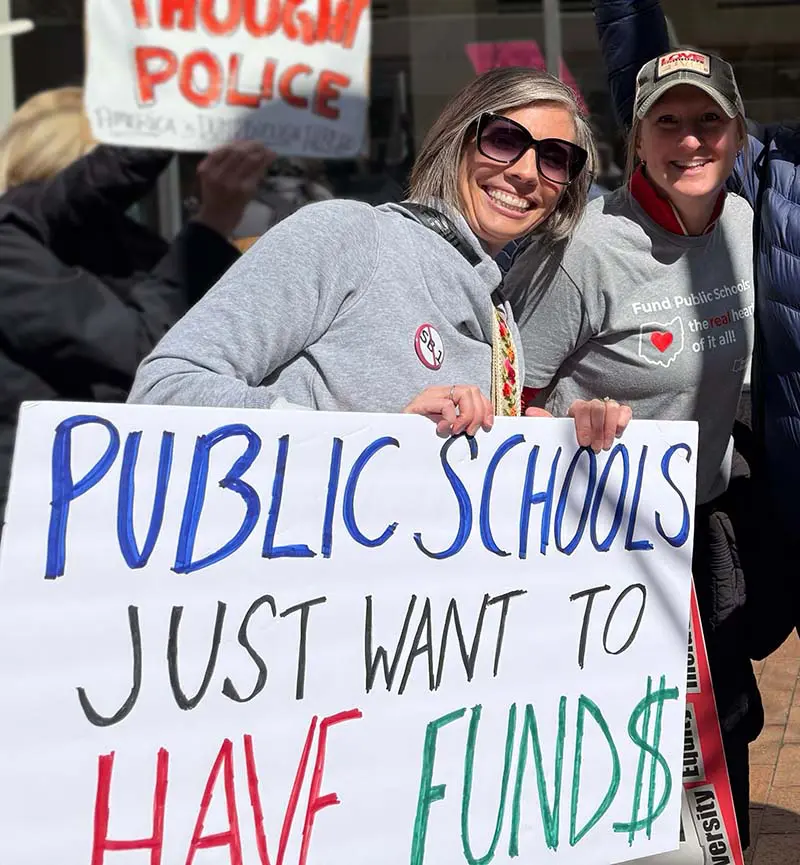
Showing Up: Protests, Boycotts, & Beyond
Do you know how often we hear women all over the country say, “I thought I was the only one!”?
We can’t let loud extremists make it seem like they’re more powerful than they are. Visible opposition serves two main purposes:
- It shows people who share your values that they aren’t alone.
- It shows your representatives that the majority — common-sense Americans who want our kids to be safe and our politics to be sane — will not be silent.
Often, people think of “opposition” as big, like a massive protest event. But small actions often add up to a big impact, and sometimes, when we generate just a little bit of friction, it’s enough to slow down the extremist agenda.
Seeing the full impact of your opposition can take time. Be honest with your group and encourage them to think about resistance movements throughout history. Years of work — including, but not limited to, protests — went into making the goals of each a reality.
“Go to joyful mode, surprising mode, flash mob mode … Get people’s attention and provide a positive message. Show that there are human beings doing unpredictable things.”
Learn from the Past
Get Involved
Learn about opposition and resistance from the past
School desegregation in the U.S., Nazi opposition during WWII, Poland’s Solidarity Movement, ACT UP’s response to the AIDS crisis, and more — we have so many examples of powerful opposition activity that changed the world community by community. You and your group can learn about them together.
Actions:
- Read and discuss a book, such as The Rebellious Life of Mrs. Rosa Parks by Jeanne Theoharis or No Logo by Naomi Klein.
- Take advantage of an online resource on non-violent opposition from The Commons Social Change Library. There is even a Global Nonviolent Action Database you can access.
- Watch a documentary film like Pride, Freedom Writers, or The Janes and discuss as a group how to apply what you learned.
- Bring in a speaker to share knowledge. This is also a great way to learn about potential partners with whom you may want to work in coalition.
“One of the things that has to be faced is the process of waiting to change the system, how much we have got to do to find out who we are, where we have come from and where we are going.”
ACTION: Learn about joy as an act of resistance.
Activists often pour their energy into resisting injustice, but it’s just as important to remember what we’re fighting for: fairness, dignity, and lives filled with meaning and connection. These things are rooted in joy. Practicing joy — especially in community — can be a powerful reminder of our shared humanity.
- Black feminist poet Toi Derricotte captured this sentiment in her 2009 poem The Telly Cycle, writing, “Joy is an act of resistance.” This line has become a motivator for those who are working to make the world a better place — choosing joy is both important and intentional. Read and discuss this poem as a group.
- Read NYT bestselling author Adrienne Maree Brown’s book Pleasure Activism: The Politics of Feeling Good. The title sums up the book’s premise — doing good doesn’t have to feel bad but actually can be a source of joy and pleasure.
Learn what makes a boycott work
From the Boston Tea Party to the Montgomery Bus Boycott, boycotts have helped shape American history. When organized effectively, they send a strong message and can lead to real change. Here are some meaningful ways your group can explore the history and impact of boycotts.
Actions:
- Visit a local museum or historical site that highlights a significant boycott. For example, the National Civil Rights Museum in Memphis features exhibits about the Montgomery Bus Boycott and other key events from the Civil Rights Movement.
- Read a book, listen to a podcast, review an article, or watch a documentary as a group — Eyes on the Prize, an Emmy-winning series on the American civil rights movement from the 1950s through the 1980s, is a great start.
- Invite a speaker to your next meeting. Consider inviting someone from a local chapter of the NAACP, the Southern Poverty Law Center, or the ACLU. They can share the history of boycotts and how they can be most effective.
Get Involved: Protests, Boycotts, & Beyond
While protesting has value and serves a purpose, it is not — and should not be — the only way your group practices visible opposition. Your group can also resist by refusing to comply or disrupting business as usual, all of which can be extremely effective.
When choosing a tactic, focus on the tangible impact. Framing it in cause-and-effect terms — like “Doing X will cause Y to happen” — can help motivate group members.
ACTION: Protests, marches, and rallies.
Showing up together in the streets has been an opposition tactic since our country’s beginning. Get more out of participating in protests.
- Host a sign-making event before the protest. It’s a great way to connect with your members, and be sure to take pics!
- Gather your group members, and go to the protest together.
- If organizing a protest or rally, use our guide to help you plan, make sure to have a call to action or “next step” for participants after the protest.
- Use the event as an opportunity to grow your group by tabling or planning a post-protest gathering at a coffee shop or restaurant. Engage fellow protesters in conversation and invite them along. Have on hand cards or flyers with a QR code to join, to give to your new friends.
- Notify your local news in advance about the event and your participation.
- Read through this extensive list of non-violent opposition actions and these creative ideas to brainstorm additional actions for your community.
ACTION: Make banners and signs, and host visibility events.
Another way to begin to get opposition messaging out into the community is through physical signs. Your group can create signs and use them for communicating with people as they drive or walk by.
- Sign-making is inexpensive, and signage events can be held on a regular basis.
- The Visibility Brigade offers detailed guidance on getting started. As with protests, make sure you know the local rules around where you can hold any kind of demonstration and what rights you have as a protester or demonstrator.

Thoughtfully practice economic boycotts
Stand up for your values with your dollars. Talk to community members and other organizations to learn whether a boycott will have the impact you want. If boycotting a retailer hurts Black or LGBTQ+ designers selling products there, perhaps a full boycott isn’t the right move but intentionally supporting only certain designers is.
Boycotts take time to have an impact, so we can’t give up early. When we act with our dollars, we send a very important message, and it’s especially an action that any of us with privilege can take.
Actions:
- Make and share lists of Black-owned businesses, women-owned businesses, vet-owned businesses, and LGBTQ+-owned businesses, spending intentionally while boycotting others. For local businesses to support, Blue Local can help you search by city or zip code. If you like to buy from farms, the Black Farmers Index will help you find Black-owned farms near you.
- Choose different service providers once extremist enablers are known (e.g., DuckDuckGo is a search engine that didn’t go along with the renaming of the Gulf of Mexico like Google).
- Learn about the companies you buy from and their senior executives by referring to the Goods Unite Us app or Boycat app. Goods Unite Us has spent thousands of hours vetting companies’ political expenditures in federal elections, while Boycat focuses on researching brands to help people make more ethical shopping choices.
- Identify companies standing up for groups or against extreme policies, and have your group send out thank-you cards to encourage them to continue to stand strong.

Push back against book bans wherever they occur
Both public libraries and school libraries have been under attack by those seeking to ban the freedom to read. Your group can monitor and fight back wherever bans are occurring in your community.
Actions:
- Use Red Wine & Blue’s Parent Playbook as a guide to plan your actions. Prepare to speak out against bans, particularly at school board and county commissioner meetings.
- Report book bans to PEN America when you become aware of them. Pen America tracks bans nationwide and fights censorship in public schools and libraries.
- Find a community tabling opportunity and pass out banned books as you chat with community members about the threats facing your schools. TroubleNation groups can request free boxes of books to hand out at your event.
Note: This is a special benefit just for TroubleNation groups, so we’re not sharing the link here. But once you join, we’ll walk you through everything you need to know!
ACTION: Stand up against attacks on public education.
- Host a public event to defend the freedom to learn, using the toolkit provided by Zinn Education Project, an organization that promotes and supports the teaching of people’s history in classrooms across the country.
- Once you have your event planned, add it to our Teach Truth Day of Action calendar on the TroubleNation website.
ACTION: Disrupt an extremist’s speaking engagement.
Practice joy as an act of resistance
Do not let extremists steal your group’s joy! Joy can be a powerful tool to disrupt fear and hopelessness. See choosing and experiencing joy as an act of freedom.
Actions:
- Find ways to celebrate diversity in your community outwardly.
- Read and discuss banned books.
- Decorate a teacher’s lounge at a school that is underfunded and needs assistance.
“I joined Hoke County TroubleNation leader Mikki’s April book club, and it was the community and connection we all needed!!! It reminded all of us that sometimes resistance is coming together, eating food, and counting our joy!”

Nebraska TroubleNation group, The Write Stuff, marching in local Pride parade

A sign-making party outside Cleveland, Ohio
ACTION: Paint rocks with messages and distribute them in your community.
ACTION: Make political message pumpkins to avoid your HOA’s sign rules.
ACTION: Support your local institutions that are working to keep the lights on.
The federal freezing of funds has a trickle-down effect felt in local communities. Your group can push back by actively supporting these institutions.
- Frequent your local library.
- Visit museums and purchase annual passes to keep them in operation.
- Visit national parks (and even volunteer your group for cleanup projects).
ACTION: Engage in Craftivism.
“Craftivism” is the intersection of crafting and the pursuit of political change. Crafters gather in groups to practice their arts as a means of building power and agency and spreading a message. Craftivism can also be used to take on a bigger mission when people come together to produce something collectively that makes a political statement or serves a community need. Here are a few ideas:
- Get together to make friendship bracelets with empowering messages.
- Host a monthly Bitch and Stitch at a local coffee shop.
- Recycle campaign signs to create impactful messaging you can use in your community.
- Make hand-crafted cards to send to the elderly via Meals on Wheels or through your local assisted living facility.
- Host a “make and take” event while simultaneously educating participants on a community issue.
- Hand paint t-shirts to then wear out in the community.
- Make and sell crafts to raise money for a community need.
Draw attention to extremism — and slow it down
Opposing harmful policies isn’t always about stopping them outright (though we’d love that!). Sometimes, it’s about shining a bright light on what’s happening and being just disruptive enough to delay or complicate the process in order to protect those who will be impacted by the policy.
Actions:
- Push back on a school board’s anti-LGBTQ+ stance by showing up to meetings in rainbow shirts or decorating the road to the meeting with Pride flags, or organizing a crowd to fill the room in silent protest.
- Pick your battles strategically. Look for moments where highlighting an unpopular proposal — like a County Commission decision or school board policy — can put pressure on key decision-makers.
- Your members can demand that a study happen before a vote on bad policy is taken. Delays can drain momentum — and sometimes a delay can yield a “win.”
ACTION: Push back where reproductive health care is under attack.
Plan C is a great organization offering information, support, and access to abortion pills. They also provide free stickers you can post in public places to spread the word about how to safely get medication.
- You can also create your own stickers, flyers, and info cards with local resources for birth control and reproductive care in your community. Share them in libraries, coffee shops, community centers — wherever people might need them.
Push back on the removal of diversity, equity, and inclusion (DEI) policies
Across the federal government, the private sector, and local governments, DEI policies have been rolled back or dismantled. Now is the time to show support for companies and institutions that have held firm in their commitment to diversity, equity, and inclusion.
Actions:
- Support businesses that have kept diversity, equity, and inclusion in place by using a DEI tracker (built by two Black women) to guide your choices — or build your own tracker as a group project.
- For businesses that have dropped these programs, consider visiting in person to deliver letters expressing your disappointment and informing them you’ll be taking your business elsewhere. Leave letters with the store manager and ask them to send them to corporate headquarters.
- Create a resource list for local Black, women, or LGBTQ+-owned businesses and circulate it among your community.
Additional Resources: Showing Up
Online resource for non-violent opposition
List of non-violent opposition actions
Creative protest ideas
The Visibility Brigade protesting template
Know your rights as a protester or demonstrator
Black-owned businesses list
Blue Local for finding local progressive businesses
Black-owned farms list
DuckDuckGo search engine
Goods Unite Us app for vetting political expenditures by companies
Boycat app for researching ethical brands
PEN America for tracking book bans
Zinn Education Project Teach Truth toolkit
Teach Truth Day of Action calendar
Liberal Rocks for activism
Plan C for abortion healthcare information
DEI tracker to find businesses supporting diversity, equity, and inclusion
